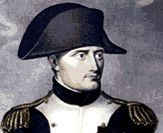 |
 |
 |
Napoleon Bonaparte (4)Emperor of France 12
Portraits of Napoleon Bonaparte
With the way to Vienna clear, Bonaparte occupied the enemy capital and then set out after the Russians and the remaining Austrian forces. He caught them at Austerlitz where, with tactical brilliance, he tricked them in to attacking him and proceeded to destroy them. The victory led to the Peace of Pressburg and Austria was forced to give up huge areas of influence in Germany and Italy. With Europe pacified, the French emperor once again turned his eyes towards Britain and developed a plan to wage economic war - the Continental System - on his closest enemy. With the large number of states under either his control or influence, Bonaparte decided that by excluding Britain from trading with them he could hurt that nation's economy sufficiently to stop it bankrolling more wars on mainland Europe. Reluctantly adopted by Europe, it didn't take long for the Continental System to begin another war. In order to stop Portugal trading with Britain he sent an army through his ally Spain to enforce the blockade. Then, inexplicably, he used the presence of French troops in Spain to persuade the King Charles IV to step down and be replaced by Joseph Bonaparte. The reaction of the Spanish people could have been predicted and an uprising broke out that was to spread across the entire nation and last for six years. Bonaparte's miscalculation was to cost him more than 200,000 casualties and be a constant drain upon his resources. It was aptly dubbed "the Spanish Ulcer". |
||
|
Napoleon
Bonaparte
|
|
| Career | Portraits |
| Quotes | Family |
| Loves | Letters |
| Plots | Murdered? |
| His will | Places |
|
Era
of Napoleon
|
|
| Powers | Opponents |
| Coalitions | Allies |
| People | Timelines |
| Key sites | Shrapnel |
|
Warfare
|
|
| Campaigns | Battles |
| Armies | Generals |
| Marshals | Winners |
| Glossary | Medical |
| Weapons | 1812 War |
| Uniforms | Battlefields |
|
War
at Sea
|
|
| Naval War | Heroes |
| Artworks | Signals |
| Nelson | Trafalgar |
|
Maps
|
|
| Key Maps | Peninsula |
| Animated | 1796/1800 |
| 1809 | Russia |
|
French
Revolution
|
|
| Revolution | Guillotine |
| Posters | People |
|
Art,
Film, Games
|
|
| Education | Goya |
| Sharpe | Hornblower |
| Books | Movies |
| DVDs | Music |
| Wargames | Images |
| Cartoons | Caricatures |
|
Other
|
|
| About Us | Sources |
| Awards | Sitemap |
| Links | Militaria |
| Miniatures | Reenactors |
| Forum | Quizzes |
| Home | Waterloo Diorama |
|
Napoleonic
Auctions
|
|
| General | Miniatures |
| Militaria | |
 The
French manouevre worked brilliantly and General Mack found himself
trapped within the city of
The
French manouevre worked brilliantly and General Mack found himself
trapped within the city of